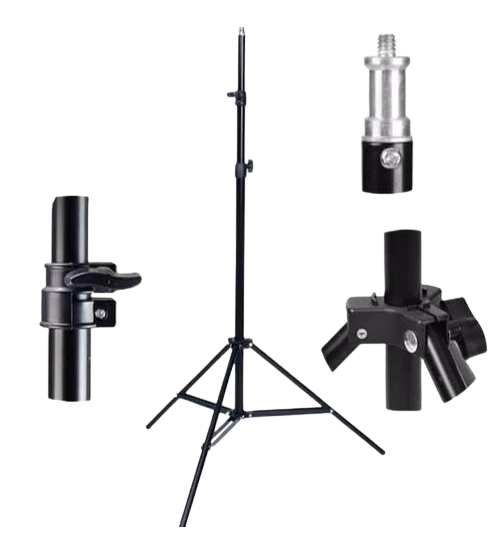LIGHTSTAND
Lihat gambar lebih detail
A plain or basic light stand is the most fundamental and common type of light stand, designed for its primary function: stably supporting lighting equipment and allowing for height adjustment. The term "plain" refers to its simple, functional design, devoid of complex or specialized features found in more professional or advanced stands.
Key Characteristics of a Plain Light Stand:
-
Simple Design:
- It typically does not feature air-cushioning. This means that when a locking knob is loosened, the stand sections will drop rapidly if not held, requiring careful handling to prevent equipment damage.
- It does not come with integrated boom arms or other multi-functional attachments as standard.
-
Construction Material:
- Commonly constructed from aluminum. This material is chosen for its balance of lightweight portability and sufficient strength to support small to medium-sized lights.
- Joints and locking mechanisms are often made from sturdy plastic or basic metal alloys.
-
Locking Mechanism:
- Utilizes twist knobs on each telescopic section to secure the desired height. This mechanism is straightforward and effective.
- The legs are also typically secured by a simple knob or lever when extended.
-
Load Capacity:
- Designed to support light to medium-weight loads, such as speedlights (external camera flashes), small LED lights, or medium-sized softboxes.
- It is generally not recommended for very large studio strobes or heavy modifiers without additional counterweights (like sandbags) on the legs.
-
Portability:
- Extremely lightweight and folds down to a compact size, making it ideal for photographers or videographers who frequently change locations or shoot outdoors.
- Easy to store and transport in equipment bags.
-
Common Use Cases:
- Perfect for beginners just starting out with studio lighting.
- Ideal for basic portrait photography, small product shoots, or vlogging setups.
- Suitable for fill lights or hair lights that do not require overly complex positioning.
Main Benefits of a Plain Light Stand:
- Cost-Effective: Significantly more affordable than other types of light stands with advanced features.
- Lightweight & Portable: Very easy to carry and set up in various locations.
- Core Functionality: Performs its primary duty of supporting lights reliably.
Limitations (Compared to More Advanced Stands):
- Lacks air-cushioning, requiring more caution when lowering equipment.
- Less stable for very heavy loads or in windy conditions (necessitates sandbags).
- Not designed for extreme flexibility like C-stands.
| Technical | |
| Warranty | - |

